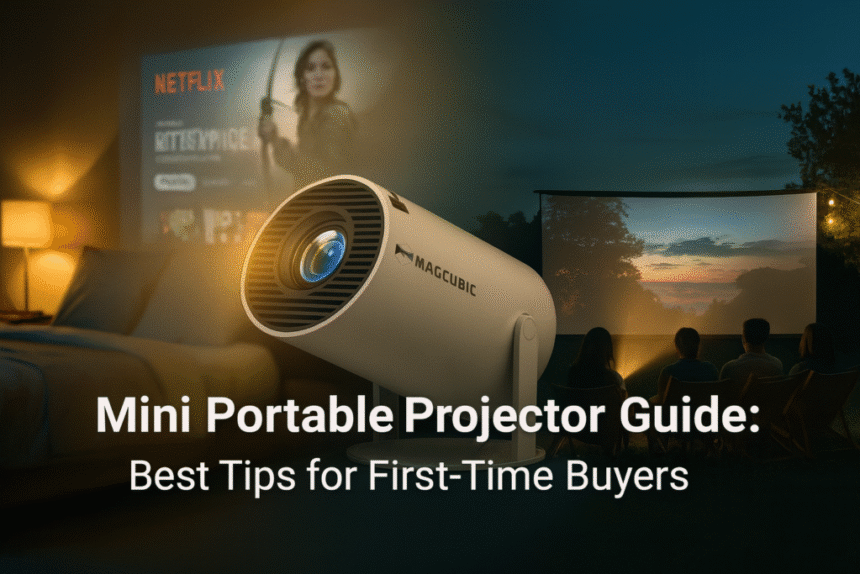Introduction
The first time I thought about getting a projector had nothing to do with tech specs—it was about space. My room was too small for a TV, and after moving houses a couple of times, I got tired of hauling heavy screens around. A friend suggested I try a mini portable projector, and that’s when things changed.
Imagine putting a box no bigger than a lunch container on your nightstand, aiming it at a blank wall, and suddenly your room turns into a personal cinema. That’s the magic of mini projectors.
But here’s the catch: shopping for your first one can be overwhelming. The internet is full of numbers—200 ANSI, 1080P, “supports 4K,” built-in apps or not—and half of it sounds like marketing jargon. If you’re a first-time buyer, you don’t need all that noise. You just need to know what matters, what doesn’t, and how to avoid wasting money. This guide cuts through the confusion and gives you practical tips from real-world use.
Why a Mini Portable Projector Makes Sense
Mini projectors aren’t just about saving money. They solve real problems and add flexibility TVs can’t match.
- Big screen in small rooms
I tried the HY300 Pro in a 12 m² bedroom, and it threw a 100-inch image on the wall. Watching Netflix on that felt way more immersive than a laptop screen. - Take it anywhere
Once you mount a TV, it stays there. A projector can move from the bedroom to the living room, or even outdoors. I’ve used mine at a friend’s backyard BBQ and on a camping trip. - Easy setup
Most new models are plug-and-play. Auto-focus and keystone correction mean you don’t spend 10 minutes adjusting the picture every time you move it. - Streaming-friendly
Many modern projectors have Netflix or YouTube built in. My friend’s HY320 NTV came with Netflix preloaded—no cables, no extra boxes.
In short: projectors offer flexibility and atmosphere. They make small spaces feel bigger and turn ordinary nights into something memorable.
Buying Tips for First-Time Users: Start with a Mini Portable Projector
Buying your first projector can feel confusing, but the good news is that beginners don’t need to chase the most expensive models. A few clear rules can help you avoid common mistakes and pick a device that actually fits your lifestyle. In fact, many first-time buyers find that starting with a mini portable projector is the easiest and safest way to explore the world of projection.
Brightness: Don’t Undershoot
Brightness is measured in ANSI lumens, and it directly affects visibility. Too low and your picture will look washed out.
| Environment | Recommended Brightness |
| Bedroom, lights off | 200–300 ANSI |
| Living room, dim | 500–700 ANSI |
| Backyard or outdoors | 700–900+ ANSI |
My HY300 Pro (200 ANSI) was perfect in a dark bedroom. But when I turned on a small lamp in the living room, it lost clarity. My friend’s HY350MAX (900 ANSI) handled outdoor dusk without a problem.
For first-time users who only need a big screen in a small room, an entry-level device is often enough. I tested the HY300 Pro in my own bedroom, and it worked far better than expected for late-night shows. This mini portable projector is a great example of what a beginner-friendly choice looks like.
Resolution: Go for 1080P if You Can
720P works for casual shows or cartoons. For movies or sports, 1080P feels much sharper. Don’t be fooled by “4K support”—that usually just means decoding 4K files, not projecting native 4K.
Built-In Apps: Convenience vs. Extra Gear
A projector with built-in Netflix or YouTube saves a lot of hassle. My friend’s HY320 NTV is a good example—it’s literally a one-click setup. Without apps, you’ll need to connect a laptop or TV stick. It works, but it’s less convenient.
Audio: Fine Indoors, Weak Outdoors
Built-in speakers are fine if you’re watching alone in a bedroom. At a backyard gathering, the sound gets lost. Adding a Bluetooth speaker changes everything.
Budget: Don’t Overpay on Day One
Projectors range from under $200 to over $1,000. First-timers don’t need to jump to the high end. Start small—something like the HY300 Pro—and upgrade later if you find yourself using it often. Spending big only to let it collect dust is the real waste.
Recommended Projectors for Beginners: Find the Best Projector for Outdoor Movies
With the basics covered, here are three models that balance price and performance for first-time buyers.
Magcubic HY300 Pro — Entry-Level Pick
- 200 ANSI, native 720P, supports 4K playback.
- Android 11 with Netflix and YouTube built in.
- Compact, 180° rotation, auto-focus.
Perfect for bedrooms or dorms—set it on a nightstand and you’ve got a cinema wall.
Magcubic HY320 NTV — Netflix Ready
- 320 ANSI, native 1080P.
- Netflix, Prime Video, and YouTube pre-installed.
- Stable wireless, voice assistant support.
Best if you hate plugging in devices and just want streaming built in.
Magcubic HY350MAX — Indoor & Outdoor All-Rounder
- 900 ANSI, supports 4K decoding.
- Runs Android 14, smooth performance.
- Auto-focus and keystone correction.
The HY350MAX is built for flexibility: bright enough for outdoor use yet compact enough for indoor movie nights. If outdoor cinema is your main priority, this guide on the best projector for outdoor movies will help you choose the right model for open-air experiences.
From Bedroom to Backyard: Outdoor Movie Magic
One of my best projector nights wasn’t indoors—it was outside. A few friends came over, we hung up a sheet in the backyard, and played an old movie. Drinks in hand, under the open sky, it felt more magical than any cinema.
But here’s the thing: not every projector can handle outdoor setups. My HY300 Pro worked in pitch-dark, but once we left a porch light on, the picture faded. My friend’s HY350MAX stayed sharp thanks to its higher brightness.
And audio? Indoors, built-in speakers are okay. Outdoors, the sound vanishes. A Bluetooth speaker made the whole experience feel complete.
If you’re planning outdoor movie nights, think about more than just specs:
- Screen vs. wall: A proper outdoor screen avoids wrinkles and improves contrast.
- Power: Some campgrounds don’t have outlets—portable power banks help.
- Noise: Fans and insects can compete with sound. External speakers solve this.
Common Mistakes First-Time Buyers Make
To wrap up the “buying advice” part, here are the traps I see people fall into most often:
- Going too dim — Buying a 200 ANSI projector for outdoor use and being disappointed.
- Believing “supports 4K” means native 4K — It doesn’t. True 4K costs much more.
- Ignoring sound — Built-in speakers won’t cut it for groups.
- Overspending — Buying a $1,000 model and barely using it.
- Forgetting portability — A heavy projector defeats the purpose of “portable.”
Conclusion
Buying your first projector doesn’t need to feel like studying a tech manual. Forget memorizing specs—focus on three questions: Where will you use it? What matters most to you? And how much are you comfortable spending?
- Bedroom binge nights → HY300 Pro is more than enough.
- Daily streaming fans → HY320 NTV keeps things simple.
- Indoor + outdoor flexibility → HY350MAX or HY450C are the safe bets.
There’s no one-size-fits-all “best projector.” The right choice depends on your lifestyle. For me, a projector turned out to be more than just a gadget—it’s a way to set the mood. Whether it’s a solo late-night show in the bedroom or a backyard cinema with friends, the right projector can turn an ordinary night into something you’ll remember.


